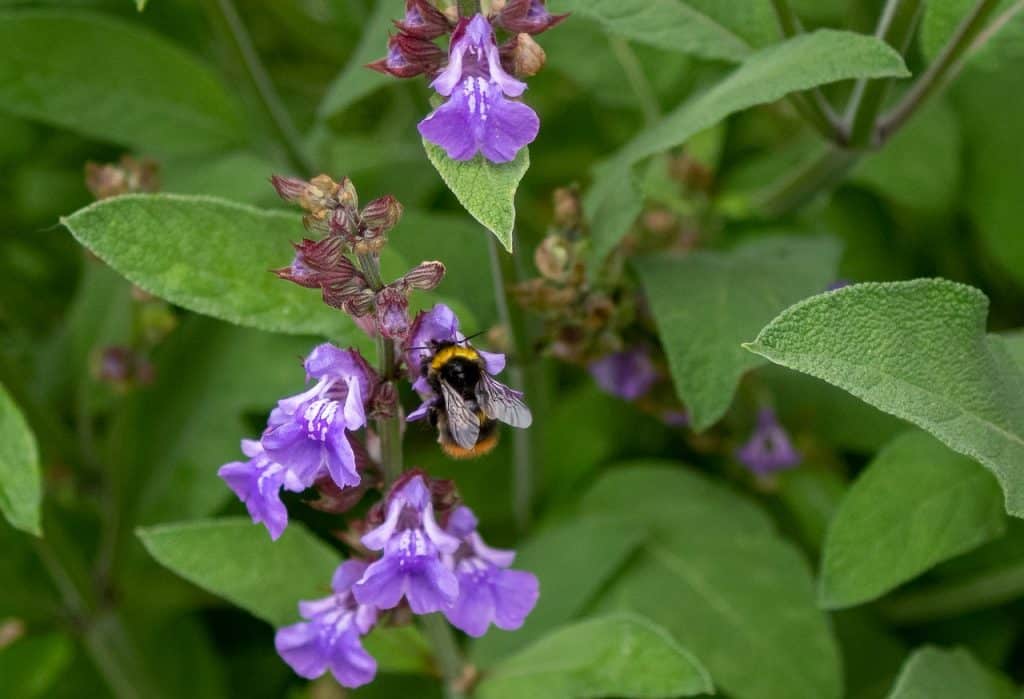Residence in Bulgaria:
In our country, the herb is found as a wild plant in the warmer regions of the country, in southern and southeastern Bulgaria. It is also grown in gardens as a flower.
Description:

Biennial or perennial semi-shrubby plant. The root is highly developed, penetrating deep into the ground. The stems are numerous, 80–100 cm high, four-edged, branched, herbaceous above, woody below, usually gray-brown in color. The leaves are opposite in two, pointed, warty often rough above, almost gray, with white veins. Younger leaves are gray fibrous, and older leaves are green, more so on the upper side. The flowers are large, with a violet up to 3 cm long corolla, arranged in 6 to 12 spines. The calyx has funnel-shaped pointed lobes, bell-shaped, double-lipped. The upper lip has three and the lower lip has two teeth. The corolla is tubular, with hairs inside. The stamens are 2, with strongly curved stalks. The fruit is composed of 4 nutlets, disintegrating when ripe. The herb can be cultivated
Usable parts:
Shortly before flowering, the upper parts with the color and the lower leafy parts of the plant are harvested
Collection time:
May - November
Composition of the herb:
Contains essential oil up to 2.5 %, in the composition of
which include cineole, alpha-pinene, salvene, borneol, d-camphor,grated The drug also contains saponins, catechins, some triterpenes, etc. The seeds contain a dried oil, which contains the glyceride of linoleic acid. The leaves also contain alkaloids, flavonoids, oleanolic acid, uvaol and paradiphenol. The plant also contains vitamins C, PP and A.
Therapeutic effect:
Anti-inflammatory, blood-purifying, antibacterial, regulates the body's secretory functions, burning effect
Usage:
Sage has been known as a medicine since ancient times.
It is used for angina, bronchitis, excruciating mess, laryngitis, грип. Dizziness, seizures, weak nerves, paralysis. Rheumatism, tendovaginitis, arthritis. Mastopathy, trembling of the limbs. Night sweats and bedwetting. The drug is used in gastrointestinal diseases, ulcers, gastritis, colitis, diarrhea, hemorrhoids, liver inflammations, bilious and kidney ailments. It can be successfully used when weaning the child to reduce the milk supply of the nursing mother. It is also used for spring fatigue, insomnia, diabetes.
Ways of use:
Internally: 2 teaspoons of finely chopped drug is poured with 400 ml of boiling water, left to soak until it cools, then strained and drunk in 2-3 hours, one tablespoon at a time. It can also be used in the form of a tincture of 70 % alcohol and drug, in a ratio of 10:2, taking 15–20 drops in 50 ml of water, 3–5 times a day.
Externally: To enforce at white discharge, wounds, rashes, eczema, purulent foci on the gums, sprains, insect stings, rubs after illness.
The herb is not toxic!
Bulgarian traditional usage:
Decoction of sage tea drink for cardiovascular problems, flatulence and diarrhea, in combination with Zhivovlek - for stomach ulcers. A decoction of the roots is used for bedwetting. A decoction of several stalks is drunk for shortness of breath. Against smallpox and typhus, drink a decoction of Garden tea and St. John's Wort. Brewedfrom Garden tea in wine, it is used to apply purulent wounds, bruises, sprains, gout and rheumatism. Decoction of Garden tea, Живовлек и Камшиче се пие при кръвохрачене и повръщане на кръв, dysentery, prolonged menstruation, seizures, palpitations, as a diuretic and choleretic.
Important:
Not to be used by pregnant women
Do not use by children

